
I find it difficult to accept some of these cause effect equations. Particularly when the the north west passage seems to be slaming shut. and antarctica is finally having a good ice year after decades of steady increase nicely balancing whatever we thought was happening up north.
The sulphur tale is good. all we need is some measure of technical support. however missing Sahara dust is way more compelling. all by itself, it can allow a warmer Gulf stream.
I am one of those who want that extra half of a degree in total global heat rather than the .0** something or other that we have received since 1943.
What we are now tracking is an anomally, just like the 2012 event that warmed the north for a decade.
WTF is Happening? An Overview
Eliot Jacobson, Ph.D.June 12, 202328 Comments
As of June 10, 2023, worldwide data showed the remarkable concurrence of three dramatic climate events.
The first WTF is in the Antarctic, where sea-ice extent is setting record lows daily, now fully over 2 million kilometers below the 1991-2020 mean. This is not some one-off event. A decline like this has long been predicted. The impact is that there is a lot more open ocean than normal for this time of year. Open ocean means the ability to absorb incoming solar radiation, and that means further heating in a well-known feedback loop.
Using JAXA data, I prepared an image to illustrate just how crazy this moment is. The way you read the image below is that each horizontal blue wavy line is a year’s worth of measured sea-ice extent. Starting with the average extent over the period 1991-2020, I simply compare each day’s extent with that average and plot that point on the year’s blue line. The years shown in this image are 1991-2023, with 2023 in red to highlight just how unusual it is. For those of you with keen eyes, the dip at the lower right corresponds to the year 2016, the year after that last El Niño, and a harbinger of what may lie ahead.

Below is a picture courtesy of Kevin Pluck using NSISC data that shows daily Antarctic sea ice extent. 2023 is represented by the blue line that’s well below the rest of the data.
For the second WTF we are going to move from the ocean to land and consider global 2-meter surface temperatures, where on June 10, for the third consecutive day temperatures breached the 1.5°C barrier (above the 1850-1900 IPCC baseline). This is not the same as breaking the Paris 1.5°C barrier, which requires the long-term planetary average to be above 1.5°C. Nor is it the same as breaching 1.5°C for the year. These temperature spikes have happened many times before. But this breach does act as a benchmark for the inevitable future that’s coming. For those who like statistics, on June 9, global 2m temperatures reached 4.8 standard deviations above the 1979-2000 mean.
And the third WTF is perhaps the furthest from any notion of normalcy. WTF is happening to the world’s oceans, and in particular the North Atlantic? Ocean temperatures have been setting unprecedented daily records, spiking to highs that are shocking climate scientists, as they look for possible reasons.
Here is a picture from ClimateReanalyzer.com that gives a sense of world sea surface temperature anomalies on June 10:
The following shows daily global sea-surface temperature (SST) anomalies over the region 60S-60N., for the years 1982-2022 in their entirety and through June 10 for the year 2023 (using this data).
The recent spike is hard to ignore. This should be the story by itself, and indeed international media has been giving it some attention. But there is a more localized story of ocean heating that I want to focus on.
And here is the true WTF image — the North Atlantic SST anomaly (using this data):
Since I first published the North Atlantic image on Twitter, this image has gone viral internationally. As of this writing, it has attracted over 2.7 million views on Twitter and has been featured in media worldwide. That’s how hungry people are to know what’s happening. The current North Atlantic anomaly is why I am writing this post and will be the subject of everything that follows.
The CERES website publishes monthly updates to what is commonly known as the Earth Energy Imbalance or EEI. This data allows us to know the difference between incoming solar radiation and outgoing radiation from all sources. That difference is the effective rate of heating of the planet. As of March, 2023, on an annualized basis, the EEI was 1.61 Watts per square meter. That might not sound like a lot, but on a global basis it is about equal to the energy released from 13 Hiroshima sized nuclear bombs exploding every second.
As you probably know, the planet’s oceans absorb about 89% of the excess heat generated by global warming. Over the last three La Niña years on average, the ocean’s share of the EEI has been equivalent to about 9.8 Hiroshima bombs per second, or about 930 million Hiroshimas in total. The ocean is hot and getting hotter all the time, the total heat content of the ocean is at record highs, but until now we haven’t directly seen that heat make its way to the surface.
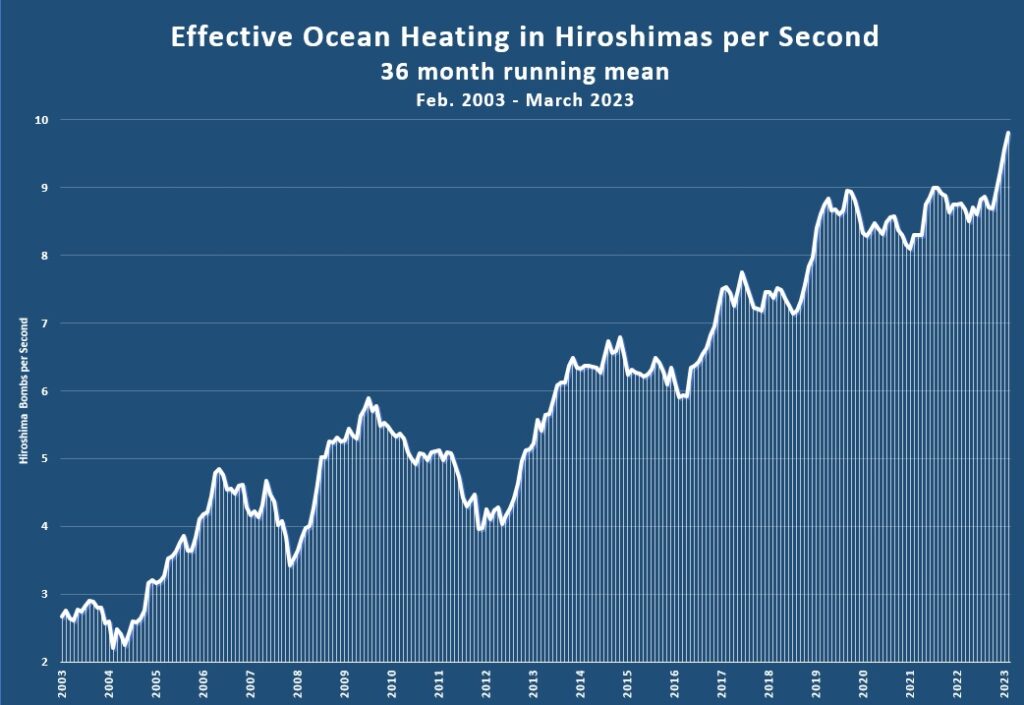
There is an obvious reason to explain some of the ocean heating that is happening right now: the unexpectedly rapid onset of El Niño, which typically drives massive surface heating of the Eastern tropical pacific. But what about other parts of the ocean? What about the North Atlantic?
Here’s where things get esoteric. As of January 1, 2020, the International Maritime Organization (IMO) put a limit on the sulfur content in shipping fuels, reducing the global upper limit on sulfur content from 3.50% to 0.50%. This policy is referred to as IMO 2020. Here is a link to an article describing this change. This reduced limit was mandatory and led to over a 75% drop in the emission of sulfur oxides. While great for the environment in many respects (e.g. less acid rain and ocean acidification), there was also a not-so-unexpected consequence.
Sulfate aerosols, in combination with atmospheric particulates, increase the amount of incoming sunlight reflected away from the Earth, effectively dimming the planet’s surface. Lasting only weeks to months in the atmosphere, these sulfate aerosols must be continually replenished to have their cooling impact. The IPCC suggests that current sulfur aerosol levels are contributing in the neighborhood of 0.5° C to total global cooling, offsetting warming that would otherwise rapidly occur. This is commonly known as “global dimming.”
By cleaning up shipping fuels, massive regions of the world’s oceans that were protected from heating by shipping sulfate aerosols are now experiencing rapid warming. This includes the main shipping routes between Asia and the Western US as well as the major routes from the Eastern US to Europe and the Middle East. And that’s where the warming is happening. This rapid heating is known as “termination shock,” and it appears to be, at least in part, what’s happening right now.
This image, shared by Leon Simons on Twitter, highlights the regions of the oceans most impacted by this sudden change in sulfur content:
There is another possible input to this heating worthy of note. Dust from the Sahara typically blows west this time of year, blocking incoming radiation while trapping existing heat. So far this year, the dust has not come. The lack of dust is notable and could also be a direct cause of some of the North Atlantic heating. For more, here is an article on the topic.
And don’t forget about the Hunga Tonga-Hunga Ha’apai explosive underwater volcanic eruption on January 15, 2022 that sent massive plumes of water vapor into the stratosphere. While I don’t know of any direct connection of this event to recent ocean warming, the linked article shows there is wide-spread consensus that this event could accelerate global warming over the next few years. However, it is not at all clear how generalized global warming of the atmosphere from stratospheric water vapor could cause a relatively sudden spike in ocean temperatures.
It is my opinion that the combination of years of ocean heating generated by the Earth energy imbalance, heating in Antarctica due to open ocean, shifts in winds and surface heating due to El Niño, lack of Saharan dust, and IMO 2020 have together triggered unprecedented ocean surface warming. I don’t have the expertise to put these in any particular causal order, but that doesn’t really matter. The consequences are clear.
As we enter Northern hemisphere summer, large regions of the planet will experience all-time record heatwaves, fires, storms and flooding. These events will set records in intensity, duration and frequency. The planet’s overall temperature will spike to new highs for the modern era, with 1.5°C in sight for 2024. Antarctic polar sea-ice will continue its retreat from “normal”, exposing more open ocean to incoming solar radiation and heating, especially as the sun returns later this year. Crops will fail. Infrastructure will break beyond repair. Climate migration will spike. Meanwhile, carbon dioxide from anthropogenic sources continues to spew at a near-record rate, while the Paris limit of 1.5°C requires these emissions be reduced about 7% per year for the next decade.
And this is all happening in the midst of the current political and social chaos, while the world attempts to recover from a pandemic that is still ongoing but mostly ignored by global media.
These next two years are a preamble to what it will mean for the world to pass the Paris 1.5°C barrier. The end of global industrial civilization is where we are headed right now, not at some future dystopian moment. I wish I had a hopeful word to end with. But I don’t.
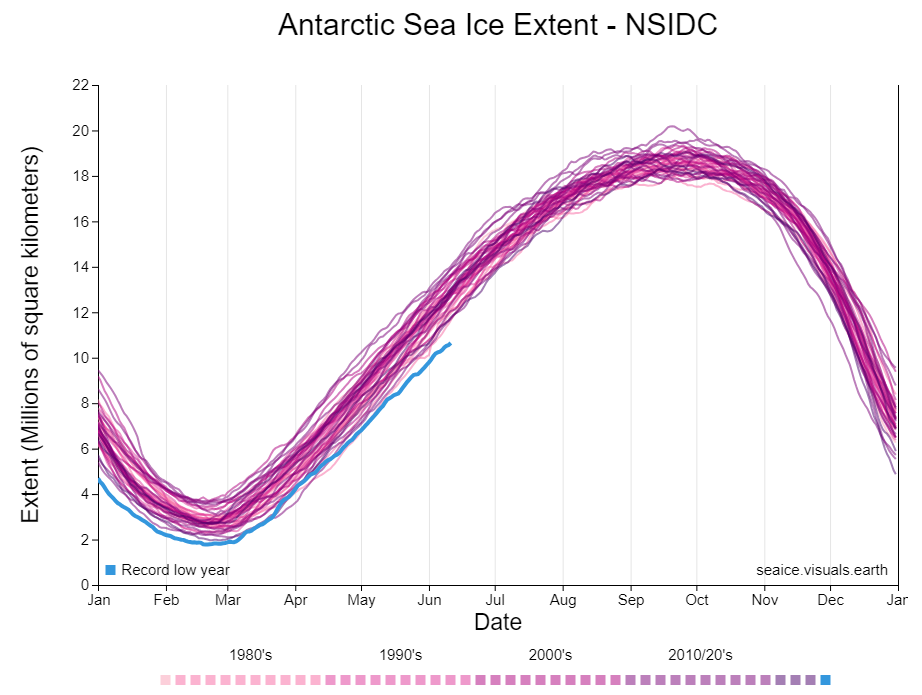

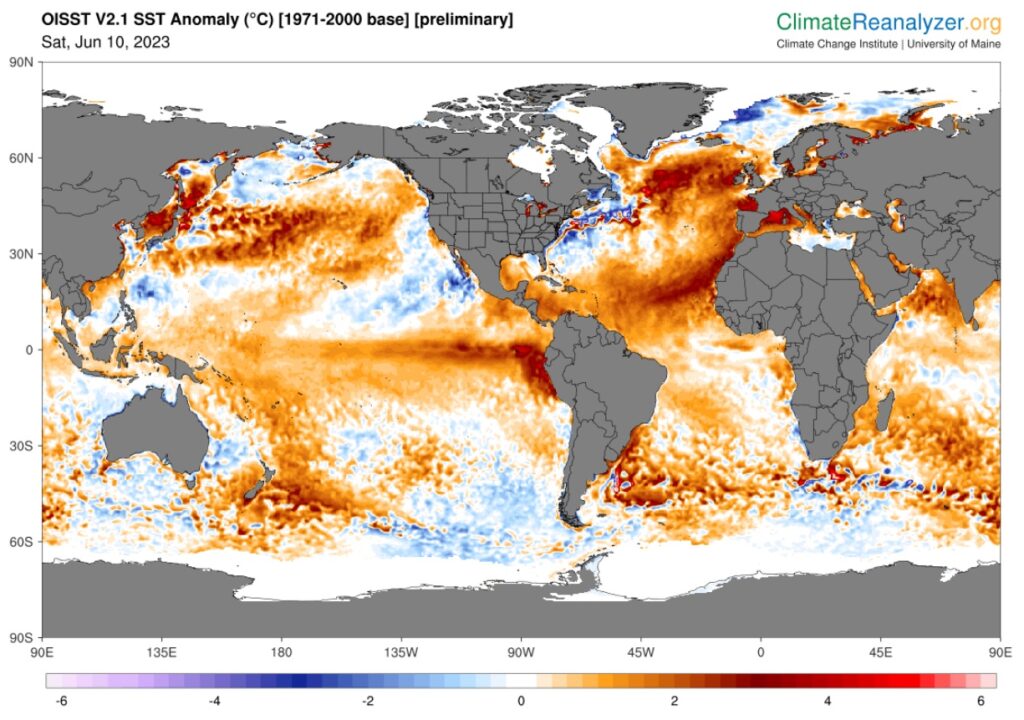
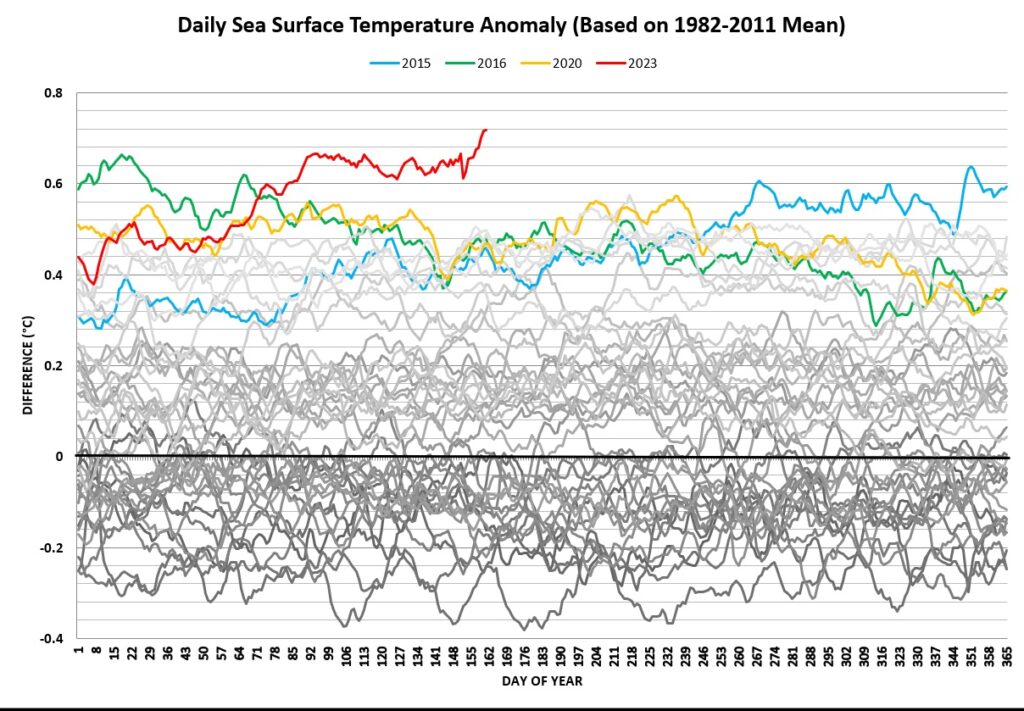

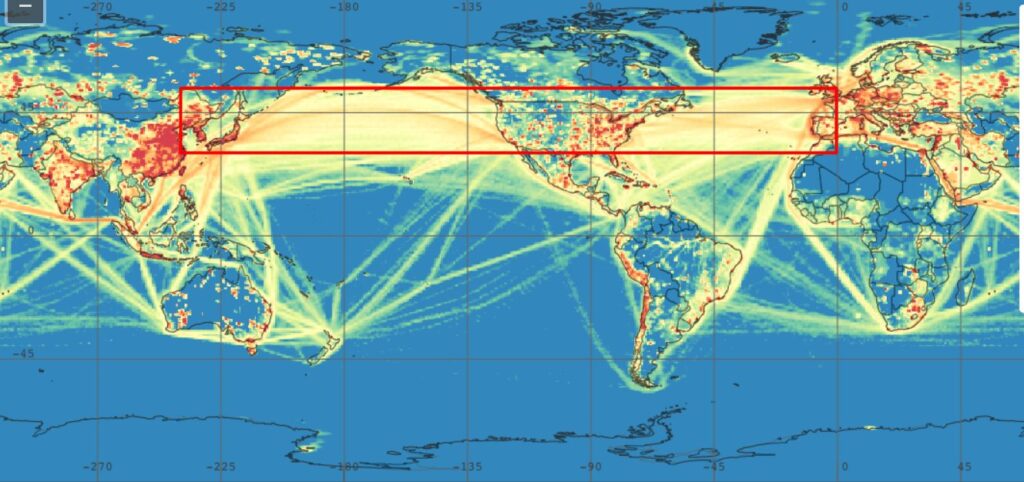
1 comment:
All I know is that the 2023 sea level at the base of the Statue of Liberty is about the same as it was in 1935. I just now looked up the pictures. The sea level at Her feet has not risen AT ALL.
I refuse to buy into the climate change hysteria of the control freak fascist left. Climate change isn't the problem. Those that spread fear based LIES about it so they can exercise more government control,they are the problem.
SamFox
Post a Comment